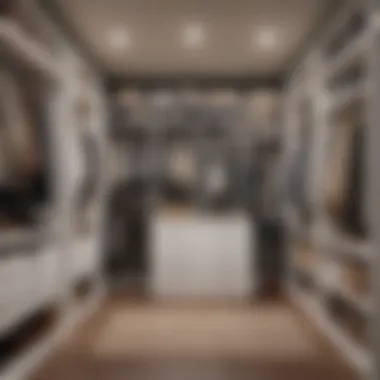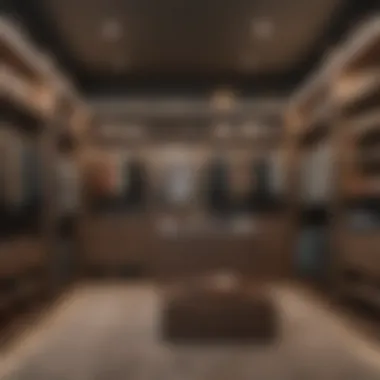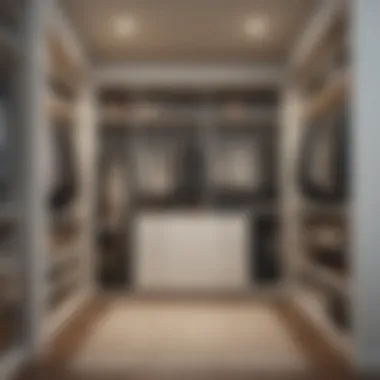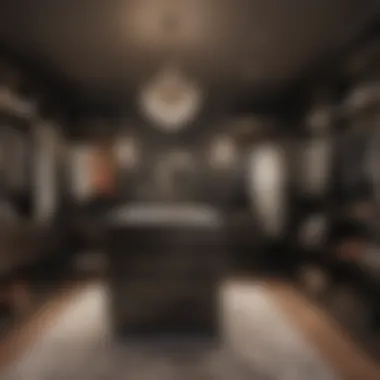Optimizing Your Walk-In Closet: A Comprehensive Guide


Intro
Creating a well-organized walk-in closet is not just about aesthetics; it serves a practical purpose in easing daily routines. A walk-in closet can be a personal sanctuary, where clothing, accessories, and footwear are easily accessible and beautifully arranged. With some thoughtful planning and consideration, this space can become both functional and visually pleasing.
Understanding the significance of layout, tools, and organization techniques is vital. This guide will cover essential strategies that can transform a common walk-in closet into a chic haven tailored to your tastes and needs.
Key Insights and Trends
Current Trends in Interior Design
Currently, there is a growing emphasis on personalized spaces. Homeowners seek to express individuality in every area of their home, including closets. Mix-and-match materials and colors reflect styles ranging from minimalist to rustic. Open shelving, where visible items are arranged with care, has become increasingly popular.
Moreover, multifunctional furniture has emerged as a trend. Combining seating with storage or including a vanity area can enhance the usability of a walk-in closet. Lighting plays a crucial role as well; ample light sources can elevate the function and feel of the space.
Popular Organizational Techniques
The concept of zoning is a guiding principle for optimizing closet spaces. This involves categorizing items logically. For example, group clothing types together - hanging suits next to casual wear, or placing shoes on distinct shelving.
Using uniform hangers not only improves visual appeal but also maximizes space. Clear bins or labeled boxes can also assist in maintaining order, making it easier to locate items.
Practical Tips and How-To Guides
Step-by-Step Guide for Organizing your Walk-In Closet
- Assess Your Space: Measure the dimensions of your closet to understand its layout.
- Declutter: Remove unnecessary items. Consider donating or discarding pieces you no longer wear.
- Plan Zones: Decide on zones for different types of clothing. Allocate areas for shoes, accessories, and outerwear.
- Choose Organizational Tools: Invest in storage solutions like shelving, drawers, or baskets based on your needs.
- Style It Up: Opt for colors and materials that reflect your personality while remaining practical.
- Maintain: Regularly evaluate your closet to ensure it remains organized and functional.
Entertaining Tips
Transforming your walk-in closet can also make it a perfect space for small gatherings. Consider the layout and how each element can invite conversation. Stylish seating options can provide comfort while showcasing your organized space.
Understanding the Basics of Walk-In Closets
The concept of walk-in closets has evolved over time. They are not simply about storage; they represent a merging of functionality and style. Understanding what a walk-in closet is and its purpose allows one to appreciate all it can offer. Knowledge about these essential spaces equips homeowners with the tools they need to maximize their potential for organization and aesthetics.
Definition and Purpose
A walk-in closet is typically defined as a spacious storage area large enough for a person to enter and move around freely. It often features designated sections for hanging clothes, shelving for accessories, and sometimes drawers for smaller items. The primary purpose of a walk-in closet extends beyond mere storage. It acts as a personal dressing area, a sanctuary for clothing, accessories, and shoes, enhancing the daily routines of those who utilize them.
Walk-in closets can greatly impact the efficiency of daily activities. By providing ample space, they help individuals quickly locate the items they need, reducing the time spent searching. Moreover, a well-organized closet contributes to better maintenance of clothing, leading to prolonged product life.
Common Designs Available
There are various designs of walk-in closets. Each design has unique features to enhance both functionality and style. Here are some of the most common designs:
- Reach-in Layouts: This design prioritizes easy access to clothing and accessories. It often includes built-in shelving and hanging rods along one or more walls.
- U-Shaped Layouts: The U-shaped design provides ample storage options along three walls, allowing for maximum efficient use of space. This is good for larger collections of clothing.
- L-Shaped Layouts: This offers a good combination of shelving and hanging space in a corner setup, suitable for smaller rooms without sacrificing accessibility.
- Island Layouts: Popular in larger walk-in closets, the island layout includes a central island with drawers. It serves as a storage and display area, merging elegance with practicality.
Each design has its own strengths and can be tailored to fit the individual needs of the homeowner. Understanding these common designs aids in selecting the most suitable one for optimizing the closet space.
Assessing Your Space
Assessing your space is crucial when it comes to optimizing a walk-in closet. Accurate evaluation can lead to effective usage of the available area, ensuring that every inch serves a purpose. Understanding the unique dimensions and characteristics of your closet will help in creating a well-organized and aesthetically pleasing environment. Moreover, proper assessment can highlight potential problem areas that may require strategic solutions.
Measuring Dimensions
Measuring dimensions is the first step in the assessment process. It is essential to know the actual size of the closet to maximize space utilization. Begin by measuring the length, width, and height of your closet. Use a tape measure for accuracy, and don’t forget to note the locations of doors and windows, as these can impact your layout choices.
- Length and Width: Knowing these dimensions helps you understand how much room you have for different types of storage solutions, like shelving units or hanging rods.
- Height: Many people overlook the vertical space. High shelves can be utilized for items that are not frequently used, while shorter items can be placed lower for easy access.
By taking these basic measurements, you can create a blueprint of your closet, allowing for thoughtful planning of the arrangement. This can prevent future mishaps, such as purchasing storage items that do not fit.
Evaluating Lighting Options
Lighting is another critical factor to consider when assessing your walk-in closet. Proper lighting not only enhances visibility but also adds a sense of style. A well-lit closet facilitates easier access to your belongings.
- Natural Light: If your closet has windows, you can take advantage of natural light. However, consider how sunlight exposure can affect your items. For delicate fabrics or materials, curtains can provide protection.
- Artificial Lighting: Options like LED can be energy-efficient and provide bright light. Recessed lighting or track lights can be installed to illuminate the space evenly without taking up excess room.
- Task Lighting: Additional focused lighting near mirrors or particular storage areas can improve functionality.
Ultimately, a thoughtful approach to lighting can transform the experience of using your closet. Light can impact how colors are perceived, making it more enjoyable to select outfits.


"A well-assessed space leads to function and elegance in organizing a walk-in closet. Investing time in this stage pays off in usefulness and style."
Assessing your space is a foundational step in the journey of optimizing your walk-in closet. By measuring dimensions and evaluating lighting options, you lay the groundwork for a seamless organizing experience. These considerations pave the way for a functional yet stylish area tailored to your needs.
Organizational Principles
Organizational principles are the backbone of a functional walk-in closet. Understanding how to arrange and sort items not only enhances the visual appeal but also significantly improves efficiency when retrieving clothing and accessories. A well-organized closet can save time and reduce frustration—elements essential for a busy lifestyle.
When approaching organization, homeowners should consider what items they own, how frequently they use them, and the volume of space available. These elements are vital to crafting a space that works for individual needs and preferences. For example, keeping seasonal clothing easily accessible is crucial during specific times of the year, while seldom-used items may be stored in less convenient spots.
Categorizing Items
Categorizing items is an effective method for maximizing organization within a walk-in closet. This process involves grouping similar items together based on usage, type, or occasion. For instance, clothing can be split into categories such as 'work attire,' 'casual wear,' and 'formal outfits.'
Additionally, accessories should also be categorized. Common categories include:
- Jewelry: necklaces, bracelets, rings
- Bags: purses, totes, backpacks
- Shoes: boots, heels, sneakers
By establishing these categories, individuals can easily locate what they need and make informed choices about their outfits. Furthermore, when storage solutions are customized to fit these categories, functionality increases, reducing the time spent searching for specific items.
Utilizing Vertical Space
Utilizing vertical space is another fundamental aspect of organizing a walk-in closet effectively. Many homeowners underestimate the potential of their closet's height. High shelving or wall-mounted racks can significantly enhance storage capabilities. Here are some ideas to maximize verticality:
- Install shelves above hanging rods for additional storage.
- Use stackable bins to store off-season clothes or rarely-used items high up.
- Consider placing hooks on walls to hang bags and accessories, freeing up floor space.
Benefits of vertical organization include:
- Increased storage space without expanding the physical footprint of the closet.
- Improved visibility of items, as they can be easily accessed and viewed.
- Reduced clutter at eye level, promoting a more open and airy environment.
By employing these organizational principles—categorizing items and utilizing vertical space—homeowners can transform their walk-in closets into cohesive, functional areas. A systematic approach not only elevates the aesthetics of the space but also ensures practicality, making daily routines much smoother.
Choosing the Right Storage Solutions
Choosing the right storage solutions is vital for optimizing any walk-in closet. The correct storage can drastically improve organization, accessibility, and even the visual appeal of the space. Without appropriate storage, a closet can quickly devolve into chaos, defeating its purpose. Effective storage solutions consider factors such as the types of items stored, the available space, and the frequency of use. A well-planned storage system maximizes all available space while ensuring that everything is easy to reach.
Shelving Units
Shelving units serve as the backbone of effective closet organization. They provide a practical way to store items like shoes, bags, and folded clothing. Various types of shelving units exist, including adjustable, fixed, and floating shelves. Each type has its own advantages based on specific needs.
- Adjustable Shelves: These offer flexibility, allowing homeowners to modify the height according to the items they wish to store. This is perfect for accommodating different shoe sizes or varying clothing dimensions.
- Fixed Shelves: Sturdy and reliable, fixed shelves are suitable for items that do not need adjustment. They often work well for displaying decorative boxes or books, adding a personal touch.
- Floating Shelves: Installed on walls without visible supports, floating shelves can create the illusion of more space. They are ideal for small walk-in closets or for showcasing decorative items.
Choosing the right material for shelves also matters. Wood or composite materials provide durability, while metal shelves might offer a more industrial look and weight capacity.
Drawer Systems
Drawer systems are another essential component in maximizing closet function. They add concealment and keep smaller items like accessories or undergarments organized. When selecting drawer systems, consider the following:
- Size and Depth: Drawers should be deep enough to hold items without forcing them in. This helps avoid damage to clothing.
- Material: Solid wood offers durability, while softer materials may lessen the budget but require more frequent replacement.
- Arrangement: Organizing drawers by purpose aids in finding items quicker. For example, placing all workout gear in one drawer promotes easy access when heading to the gym.
It might also be helpful to add dividers within drawers. This keeps smaller items separate and prevents chaos, allowing for easier maintenance.
Hanging Rods and Systems
Hanging rods and systems play a significant role in utilizing vertical space effectively. They are perfect for garments that need hanging to remain wrinkle-free. When considering hanging systems, think about the following components:
- Rod Height: Installing rods at varying heights allows for maximizing storage. Long items like dresses may need a full-length rod, while shorter items like shirts benefit from additional rods at different levels.
- System Options: Options include single rods, double rods, or even pull-down systems. Double rods can double hanging capacity, making them incredibly useful in smaller closets.
- Materials: Rods made from sturdy materials support more weight. Opt for finishes that match the overall design aesthetics of the closet.
When implementing hanging systems, consider how often different clothes are used. Everyday items should be at eye level, while infrequently used pieces can go higher or lower.
Tip: Consider installing hooks or additional accessories on the back of the door or on the rod itself for accessories or bags, thereby enhancing functionality.
Effective Layout Strategies
The layout of your walk-in closet plays a crucial role in maximizing its utility and aesthetic value. Choosing the right configuration not only affects accessibility but also enhances organization. A well-planned layout can transform cluttered spaces into areas of functionality and style. Whether you're optimizing the space for quick access, efficiency, or visual appeal, understanding different layout strategies is fundamental.
U-Shaped Layout
The U-shaped layout is often favored for its ability to utilize three walls, providing ample storage and making the most of available space. This configuration allows for a seamless layout where clothes and accessories are easily accessible.


Benefits of a U-shaped layout include:
- Maximized Storage: It comes with built-in storage units that can accommodate wide-ranging items.
- Improved Organization: This design provides designated areas for different categories, from shoes to jackets.
- Ease of Movement: It creates an environment where moving between sections is simple and effective.
When implementing a U-shaped closet, insure sufficient walking space within the middle of the configuration. Measure dimensions carefully to avoid crowding, ensuring the layout remains user-friendly.
L-Shaped Layout
The L-shaped layout offers a great balance between accessibility and space-saving design. It typically comprises two contiguous walls, giving it versatility in various room shapes.
This layout is beneficial for:
- Corner Utilization: It efficiently uses corner spaces which often remain underutilized.
- Flexible Storage: You can easily incorporate shelving, drawers, or hanging rods based on personal needs.
- Clear Pathways: The design affords a clear pathway for easy navigation without obstruction.
When designing an L-shaped layout, consider the location of the door and windows to capitalize on natural light. Personalized touches can be added easily, making the closet uniquely yours.
Island Configuration
The island configuration is a luxurious touch, transforming your walk-in closet into a chic space with additional storage capabilities. This design features a central island, allowing for easy access to items on all sides.
Advantages of an island layout include:
- Centralized Organization: It provides a space to organize accessories, jewelry, or even folding items.
- Functional Surface: The top can also be used for laying out outfits, making the decision process easier.
- Enhanced Aesthetics: An island adds a significant design element, enriching the overall look of the closet.
Space availability is crucial for this design. Ensure clearance around the island for comfortable movement. Employ a cohesive design that aligns the island with the overall theme of the closet.
A well-thought-out layout can make a substantial difference in the functionality and appeal of your walk-in closet.
Choosing the right layout is a matter of personal preference as well as spatial considerations. Each strategy presents unique benefits that can enhance organization, accessibility, and style. Ultimately, the goal is to create a space that reflects your needs while remaining practical.
Maximizing Functionality
Maximizing functionality in a walk-in closet is a central theme in organizing this unique space. A well-thought-out closet should not only accommodate belongings efficiently but also enhance the user experience. When the functionality of a closet is optimized, every item can be easily accessible. This eliminates frustration often associated with searching for items. It is beneficial to rethink how items are stored and accessed within the space. By implementing strategic storage solutions and utilizing available features, homeowners can transform their closet into a well-organized haven.
Elements such as hooks, racks, and mirrors play a significant role. They help in better organization and improve the visual aesthetics of the space. Let’s delve into these aspects further.
Implementation of Hooks and Racks
Hooks and racks can maximize vertical space, freeing up valuable floor area. By installing hooks on the interior doors, one can use these often-overlooked surfaces. Hooks can easily accommodate bags, belts, and scarves. Racks, particularly adjustable ones, offer versatility. They can be used to hold various accessories and frequently used items, allowing homeowners to grab what they need with ease.
Another advantage of hooks and racks is the enhanced visibility they provide. When items are displayed, it is easier to see what is available. This lessens the chance of duplicates or buying unnecessary items. Additionally, having a designated spot for items reduces clutter, making it easier to maintain order over time. The installation process is generally straightforward, making it an accessible improvement for any homeowner looking to enhance functionality.
Incorporating Mirrors
Mirrors hold both practical and aesthetic value in a walk-in closet. Not only do they serve a functional purpose for dressing and styling, but they can also create the illusion of a larger space. By positioning mirrors strategically, light can be reflected, brightening the closet and making it appear more expansive.
Furthermore, a well-placed mirror can enhance the overall experience of using the closet. When getting dressed, having a full-length mirror helps to assess outfits easily. This can streamline the process of selecting clothing, ultimately saving time.
The design of mirrors also can add to the decor of the closet. Choosing a stylish frame can contribute to the overall theme and make the space more inviting. Different mirror styles can blend seamlessly with other design elements in the closet, thus elevating the look without sacrificing functionality.
Incorporating Style and Personal Touches
In any design, style and personalization play vital roles. In the realm of walk-in closets, they are not just about aesthetics but about reflecting individual identities. A well-styled closet enhances the overall space while allowing for self-expression. This section delves into the significance of color coordination and decorative elements to create a closet that feels uniquely yours.
Color Coordination
Choosing a color palette is fundamental in closet design. Colors can influence mood and perception. A neutral palette might evoke calmness, while vibrant hues can energize the space. Aligning your closet's color scheme with the rest of your home creates a sense of cohesion.
When selecting colors, consider the following factors:
- Personal Preference: What shades resonate with you? Choosing colors you love ensures you enjoy your closet every day.
- Functionality: Light colors can make a small space feel larger, while darker shades may add elegance and sophistication.
- Lighting: Factor in how natural and artificial light affects colors. A well-lit closet will showcase hues differently than a dimly lit one.
To coordinate effectively, you can:
- Identify Accent Colors: Choose one or two accent colors to add personality without overwhelming the space.
- Utilize Accessories: Incorporate colored bins, hangers, or baskets to introduce splashes of color.
- Mind the Finish: Different finishes (matte, glossy) can impact how colors appear. Experiment with samples before deciding.
Decorative Elements
Decorative elements serve as the finishing touches that elevate a closet from ordinary to extraordinary. They contribute both to the aesthetic appeal and functionality. Thoughtful selection of decor can transform a utilitarian space into a harmonious environment.


Here are a few suggestions for decorative enhancements:
- Artwork: Add small pieces of art or framed photos on the walls. These personal touches can bring joy and a sense of individuality.
- Rugs: A well-placed rug can add warmth and texture to your closet. Choose materials that enhance comfort underfoot while complementing your color scheme.
- Storage Solutions: Stylish containers, decorative boxes, or customized shelving can merge functionality and design. For instance, using woven baskets can add an organic feel to the area.
"A well-organized space is not just functional; it tells a story. Let your closet narrate your unique style."
Seasonal Adjustments and Maintenance
A well-organized walk-in closet can significantly enhance everyday routines. However, the changing seasons bring about new clothing needs and storage challenges. Thus, understanding the significance of seasonal adjustments and maintenance is essential for maximizing closet potential.
Maintaining organization throughout the year is crucial. Regular adjustments ensure that items are easily accessible and relevant, reducing clutter and improving efficiency. Seasonal changes often necessitate different garments. Well-planned seasonal adjustments allow homeowners to curate their collections based on current needs.
Regular Decluttering
Regular decluttering is a fundamental aspect of keeping a walk-in closet optimized. It involves reviewing items periodically to ensure they are still relevant to your wardrobe and lifestyle. Maintaining a routine where you evaluate your possessions can prevent accumulation of unnecessary items. This practice promotes a cleaner, more organized space.
- Timeline: Set specific times in the year to reassess your closet. Consider decluttering at the beginning of each season.
- Criteria: When deciding what to keep, ask the following questions:
- Donation or Discard: Arrange for items that no longer serve you. Donations can be a satisfying way to give to those in need, while discarding damaged or worn-out items maintains closet integrity.
- Have I worn this in the past year?
- Does it fit well?
- Is it still in style for me?
Effective decluttering not only frees up space but also keeps your closet functional. A simplified wardrobe allows you to easily select outfits, which can enhance your overall style and confidence.
Adapting for Seasonal Wear
Adapting for seasonal wear is equally vital. Each season brings a shift in fashion needs, necessitating the rotation of clothes and accessories. By properly addressing these changes, your walk-in closet can stay both practical and visually appealing.
- Seasonal Swap: When a season concludes, prepare for the next by swapping out clothing. Store away items that won't be worn, ensuring they are clean and properly packed to avoid damage.
- Storage Solutions: Use clear bins for seasonal items. This keeps belongings visible and allows easy access. Proper labeling aids in quick identification when it’s time to rotate collections.
- Layering Techniques: Consider the use of layering for transitional seasons. Store lighter jackets or cardigans with heavier fabrics. This flexibility facilitates ease when dressing for varying temperatures.
By embracing these practices, you can maintain balance and order in your walk-in closet regardless of the season. Regular maintenance and thoughtful adaptations ensure your closet remains a functional space tailored to your lifestyle.
Troubleshooting Common Issues
Addressing challenges in a walk-in closet is essential for maintaining its functionality and visual appeal. Homeowners often encounter specific problems that can hinder the efficiency of their shelving and storage. Understanding these common issues allows individuals to implement practical solutions, ultimately leading to a more streamlined experience in their daily routines. This section will explore two prevalent problems: insufficient space and disorganization over time.
Insufficient Space
Insufficient space is a common dilemma faced by many when organizing a walk-in closet. Regardless of the initial layout, it often seems like there is never enough room to store items adequately. This issue can stem from several factors, such as poor initial design, accumulation of belongings over time, or improper allocation of storage space.
To alleviate this problem, consider the following tips:
- Assess what you really need: Begin by removing everything from the closet. Evaluate each item and decide if it deserves a place in your space. Avoid keeping items out of obligation or sentiment.
- Utilize vertical space: Install shelves that reach higher, allowing for more items to fit without taking up floor space.
- Incorporate multifunctional furniture: Use ottomans or benches that offer storage and seating. Such solutions can help maximize limited space while adding style.
- Rotate seasonal items: Store out-of-season clothes in bins outside the closet to make more room for current essentials.
Adopting these strategies can create a more efficient closet layout.
Disorganization Over Time
Disorganization is another significant issue that can arise in walk-in closets. As time passes, maintaining organization can become challenging, especially with changing seasons or fluctuating fashion trends. Clothes may end up mixed together, shoes scattered, and accessories can become lost in the clutter.
To combat this problem, the following steps may help:
- Establish a regular routine: Set aside time monthly to declutter and rearrange the closet. Regular maintenance prevents the accumulation of items and makes it easier to find what you need when you need it.
- Invest in quality organizational tools: Using bins, baskets, and drawer organizers can create designated spaces for specific items, reducing clutter.
- Label everything: This simple strategy can significantly aid in maintaining order. Labels not only provide information on where things belong but also make it easier for anyone using the closet to find or return items.
- Create a functional layout from the start: Plan your space considering how often you access different items. Place frequently used items at eye level or within easy reach, while seldom-used items can go on higher shelves.
By addressing disorganization proactively, it becomes easier to keep a walk-in closet functional and visually pleasing.
"A well-organized closet is a pathway to ease and efficiency, turning everyday activities into enjoyable experiences."
Understanding and tackling common issues in walk-in closets is crucial for achieving a harmonious space. Solutions for insufficient space and disorganization will enhance not only the functionality of the closet but also support the overall aesthetic of the home.
Ending and Final Thoughts
In concluding our extensive exploration of walk-in closets, it is essential to recognize the integral role they play in modern living spaces. These closets are more than just storage areas; they represent a blend of function and style. An optimized walk-in closet provides homeowners with the ability to maintain a neat environment, while also ensuring easy access to their belongings.
One key benefit of careful organization is the time saved during daily routines. When everything has its designated space, finding needed items becomes straightforward. This can alleviate stress, especially during busy mornings. Moreover, a well-organized closet contributes to an overall sense of calm within the home. Chaos in one area often spills over, affecting the rest of the living environment. Hence, investing time and energy into optimizing this space pays dividends in daily life.
Beyond functionality, the aesthetic aspect cannot be overlooked. A visually pleasing closet can transform the experience of selecting outfits and accessories. By incorporating personal touches—like color coordination or decorative elements—homeowners can make this space reflective of their personality and style. This touches on the broader concept of personal branding within the home, where each room serves as a testament to individual choice and preference.
As with any living area, the walk-in closet requires ongoing maintenance. Regular decluttering is a practice that ensures the closet does not become overcrowded over time. This reinforces the importance of seasonal adjustments, where the wardrobe is evaluated based on current needs and trends.
"An organized walk-in closet is not merely about storage; it is a statement of lifestyle choice."
Considering the common issues discussed, such as insufficient space and disorganization over time, proactive steps must be utilized. Storage solutions tailored to individual needs—like shelving units and drawer systems—can counteract these problems. Furthermore, understanding the layout and design choices strengthens the foundational aspects of the closet.
Ultimately, an optimized walk-in closet stands as both a practical solution and a sophisticated statement about one’s life choices. This comprehensive guide has provided strategies and insights that empower individuals to navigate their unique spaces. With a commitment to organization and decoration, transforming a walk-in closet into a functional yet aesthetically pleasing environment is entirely attainable.
For further information on organizing spaces effectively, you may check out resources from Wikipedia, Britannica, and discussion platforms like Reddit or Facebook.



